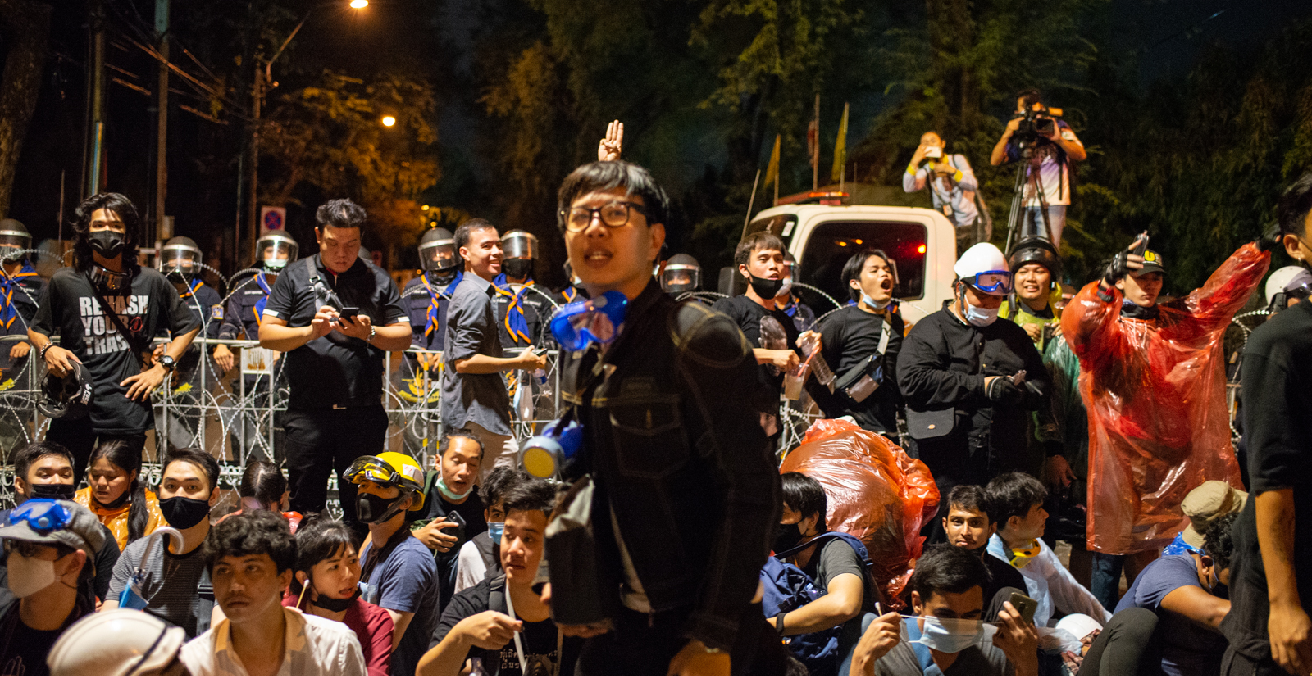Comparative Analysis of the 2020 Protests in Southeast Asia

In 2020, Thailand, Malaysia, and Indonesia witnessed youths protesting against governmental measures that were imposed during the height of the COVID-19 pandemic. There are similarities in the motives behind these protests, primarily the longing for greater transparency and democratic practices.
On 22 February 2020, hundreds of Thais, most of them university students, gathered at Thammasat University to protest against the decision of Thailand’s Constitutional Court to ban the opposition party, Future Forward Party, from running in future elections. The protests continued until October. Each time, protesters increased their demands and further denounced the autocratic measures of the Thai government under Prayuth Chan-o-cha. Similarly, on 25 February, Malaysian youths expressed their dissatisfaction with the “backdoor diplomacy” and anti-democratic measures of the Malaysian government officials by holding continuous demonstrations. In October, Indonesia witnessed youths holding rallies in various parts of the country to protest against President Jokowi’s unilateral ratification of the Omnibus Law.
Fight against autocracy
The Thai protests in 2020 were among the biggest protests in the country’s history, and for the first time in two years, protesters are currently being charged under the Lese Majeste law. The Lese Majeste law is notorious for being arbitrarily used by government officials to suppress dissents and restrain freedom of speech. Hence, Thai protesters were demanding the abolition of this law. The Thai 2020 protests were considered exceptional, as for the first time, the demands of the protesters were specific and vindictive. In particular, protesters demanded the abolition of Article 6 of the 2017 Constitution that prohibits anyone from criticising the king and the addition of an article to permit the examination of the king’s potential wrongdoings. They also demand a stop to future coups and transparent scrutiny over the king’s financial assets. These demands were rooted in the longing for a transparent electoral and political system, one in which they could freely choose their leaders, speak, and express their grievances.
In Malaysia, following the resignation of the former democratically elected prime minister, Mahathir Mohamad, on 24 February, the country experienced political turmoil with Mahathir being undemocratically selected by the king as the interim prime minister until the king then appointed incumbent Prime Minister Muhyiddin Yassin. Mahatir resigned out of frustration with party politics, where he was allegedly pressured to quickly appoint the People’s Justice Party Leader Anwar Ibrahim as the next prime minister, and would like the Dewan Rakyat (Lower House) to decide his successor instead. Like in Thailand, hundreds of Malaysian youths gathered at Dataran Merdeka on 25 February for two consecutive days, demanding an explanation for this political upheaval and pushing for another election to be held. They then held another demonstration on 1 March to boycott the newly-appointed Prime Minister Muhyiddin, carrying placards with slogans like “#notmyPM,” “backdoor government is sodomising the rakyat [people],” “uphold democracy,” and “bored with old folks.” Reflecting on nearly a decade of corrupt and authoritarian leadership under Najib Razak, Malaysian youths were clearly frustrated and called for transparency, free and fair elections, and greater democratic practices.
As for Indonesia, the development of the Omnibus Law, or the Job Creation Law, has been in parliamentary discussion since January 2020 and has received opposition from Indonesian youths and workers unions. However, despite this resistance, Indonesian President Joko Widodo and the People’s Representative Council did not consult nor compromise with the people and continued to push the ratification of the bill. Prior to this ratification, the government had adopted a revision to the Constitutional Court Law that would allow judges to extend their position ten years longer than the previous regulation. This revision is argued to further enable the government or the ruling elite to impede neutrality, intervene, and establish control over the court’s decisions on legal matters and petitions made by the people, including if the people were to challenge the Job Creation Law in court. In addition to the Job Creation Law and the revision of the Constitutional Court Law, Jokowi has imposed several measures that critics and academics consider authoritarian throughout his presidency, such as the unilateral appointment of the attorney general in 2014, changing the status of Corruption Eradication Commission employees to civil servants, and criminalising political opponents. In response, tens of thousands of youths frequently stormed the streets and held demonstrations all over the country against these governmental measures, including Jokowi’s recent unilateral ratification of the Job Creation Law.
Other motives
Some may argue that the protests in Southeast Asia were rooted in non-political motives, particularly socio-economic factors. For instance, Thai protesters insisted on having a transparent and clear distinction between the personal financial assets of the king and the ones controlled by the Ministry of Finance in their list of ten demands. They also called for a reduction in the national budget allocated to the king and to adjust the budget according to the country’s economy. Hence, the protests can be argued to reflect their grievances against the monarch’s economic privileges.
Similarly, Indonesians protested against the Omnibus Law as it would threaten job security. The law reduces the minimum wage and the mandatory compensation rights, allows greater freedom for employers to negotiate their own contract, and removes sick leave provisions. It is also expected that since the law would cut bureaucracies and simplify movements in the labour market, local Indonesians would have to compete with foreign workers. All of these would jeopardise the welfare of employees, which prompted middle-class youths and workers to protest against the law.
As for Malaysian protesters, Muhyiddin is accused of not being harsh enough against corruptors. With the wounds from former Prime Minister Najib’s 1MalaysiDevelopment Berhad (1MDB) scandal still fresh, a strong character against corruption would better appeal to the public. Furthermore, Muhyiddin has a reputation for being a conservative Malay-Muslim supremacist. Ethnic Chinese and Indians fear the possibility of worsening discriminatory policies under Muhyiddin’s leadership. Youths, as well, reject the prospect of Muhyiddin steering the country to be increasingly conservative. For these reasons, hundreds of Malaysian youths and activists protested against Muhyiddin’s appointment as prime minister.
In conclusion, there are evidently many similarities in the Thai, Malaysian, and Indonesian youth protests. Given that movements like Black Lives Matter highly attracted the attention of Southeast Asian youths, particularly on social media, and that there are increasing youth political participation and activism, the region is clearly experiencing a trend of vocal youths demanding greater democratic practices. As, historically, youths play a major role in most political revolutions, does this mean that we will see Southeast Asia becoming progressively democratic?
Gabriele Natalia Siahaan is a postgraduate student at the ANU, studying International Relations and Asia Pacific Studies. She has a passion for Southeast Asian socio-political affairs and is actively involved in ANU ASEAN Society.
This article is published under a Creative Commons License and may be republished with attribution.





